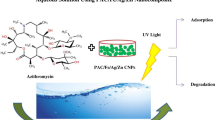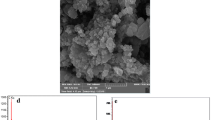Abstract
Tetracycline (TC), a widely used antibiotic, can easily enter aquatic ecosystems through soil erosion, livestock manures, and wastewater discharge, causes environmental and ecological health effects. AgCuFe2O4@Methylcellulose (MC)/Activated Carbon (AC) magnetic nanocomposite was synthesized accompanied by microwave-assisted co-precipitation procedure under green circumstances with high efficiency and subsequently utilized as a new heterogeneous magnetic nano-photocatalyst in the TC photodegradation from aqueous solutions. The structural characterization of AgCuFe2O4@MC/AC was performed by various analytical techniques. Afterwards, the key parameters of the photocatalytic TC degradation process, such as catalyst dose, TC concentration, pH, and process time, were investigated and optimized the results showed that the catalyst was synthesized on a nanometer scale (25 nm) with a quasi-spherical structure, with a high specific surface area, high magnetic strength (Ms = 19.27 emu g−1), and the preservation of the crystal structure. The removal efficiency of TC under optimal conditions including pH 7, initial TC concentration of 5 mg L−1, nano-photocatalyst dose of 0.5 g L−1, 90 min of irradiation time was reported to be 90.91% for synthetic sample and 87.17% for real wastewater sample. The removal effectiveness of total organic carbon was 85.2% under optimal conditions. The photocatalytic degradation kinetics of TC followed pseudo-first-order and Langmuir–Hinshelwood kinetic models, with values of KL–H = 0.633 L mg−1 and Kc = 0.126 mg L−1 min−1. After four cycles of recovery and regeneration, the synthesized catalyst demonstrated high chemical stability and was able to remove 62% of the pollutant. Finally, this study provides a viable approach for removing antibiotics using an AgCuFe2O4@MC/AC-based heterogeneous nanostructured photocatalyst.
Graphical Abstract





















Similar content being viewed by others
Data Availability
No datasets were generated or analysed during the current study.
References
Gharaghani MA, Samaei M, Mahdizadeh H, Nasiri A, Keshtkar M, Mohammadpour A et al (2024) An effective magnetic nanobiocomposite: preparation, characterization, and its application for adsorption removal of P-nitroaniline from aquatic environments. Environ Res 246:118128
Maleky S, Asadipour A, Nasiri A, Luque R, Faraji M (2022) Tetracycline adsorption from aqueous media by magnetically separable Fe3O4 @methylcellulose/APTMS (isotherm, kinetic and thermodynamic studies). J Polym Environ 30:3351–3367
Zhang Z, Ding C, Li Y, Ke H, Cheng G (2020) Efficient removal of tetracycline hydrochloride from aqueous solution by mesoporous cage MOF-818. SN Appl Sci. https://doi.org/10.1007/s42452-020-2514-9
Nasiri A, Golestani N, Rajabi S, Hashemi M (2024) Facile and green synthesis of recyclable, environmentally friendly, chemically stable, and cost-effective magnetic nanohybrid adsorbent for tetracycline adsorption. Heliyon 10(2):e24179
Gharaghani MA, Dehdarirad A, Mahdizadeh H, Hashemi H, Nasiri A, Samaei MR, Mohammadpour A (2024) Photocatalytic degradation of Acid Red 18 by synthesized AgCoFe2O4@ Ch/AC: recyclable, environmentally friendly, chemically stable, and cost-effective magnetic nano hybrid catalyst. Int J Biol Macromol 269:131897
Gao Y, Li Y, Zhang L, Huang H, Hu J, Shah SM et al (2012) Adsorption and removal of tetracycline antibiotics from aqueous solution by graphene oxide. J Colloid Interface Sci 368(1):540–546. https://doi.org/10.1016/j.jcis.2011.11.015
Lv JM, Ma YL, Chang X, Fan SB (2015) Removal and removing mechanism of tetracycline residue from aqueous solution by using Cu-13X. Chem Eng J 273:247–253. https://doi.org/10.1016/j.cej.2015.03.080
Shi Z, Ma A, Chen Y, Zhang M, Zhang Y, Zhou N et al (2023) The removal of tetracycline from aqueous solutions using peanut shell biochars prepared at different pyrolysis temperatures. Sustainability (Switzerland) 15(1):874
Hou L, Zhang H, Xue X (2012) Ultrasound enhanced heterogeneous activation of peroxydisulfate by magnetite catalyst for the degradation of tetracycline in water. Separ Purif Technol 84:147–152
Niu L, Zhang G, **an G, Ren Z, Wei T, Li Q et al (2021) Tetracycline degradation by persulfate activated with magnetic γ-Fe2O3/CeO2 catalyst: performance, activation mechanism and degradation pathway. Sep Purif Technol 259:118156
Wu CS, **ong ZH, Li C, Zhang JM (2015) Zeolitic imidazolate metal organic framework ZIF-8 with ultra-high adsorption capacity bound tetracycline in aqueous solution. RSC Adv 5(100):82127–82137
Nasiri A, Rajabi S, Amiri A, Fattahizade M, Hasani O, Lalehzari A et al (2022) Adsorption of tetracycline using CuCoFe2O4@Chitosan as a new and green magnetic nanohybrid adsorbent from aqueous solutions: Isotherm, kinetic and thermodynamic study. Arabian J Chem 15(8):104014
Mohammed AA, Kareem SL (2019) Adsorption of tetracycline fom wastewater by using Pistachio shell coated with ZnO nanoparticles: equilibrium, kinetic and isotherm studies. Alex Eng J 58(3):917–928
Guo Y, Huang W, Chen B, Zhao Y, Liu D, Sun Y et al (2017) Removal of tetracycline from aqueous solution by MCM-41-zeolite A loaded nano zero valent iron: synthesis, characteristic, adsorption performance and mechanism. J Hazard Mater 339:22–32
Rahimi F, Nasiri A, Hashemi M, Rajabi S, Abolghasemi S (2024) Advances in three-dimensional electrochemical degradation: A comprehensive review on pharmaceutical pollutants removal from aqueous solution. Chemosphere 362:142620. https://doi.org/10.1016/j.chemosphere.2024.142620
Asoubar S, Mehrizad A, Behnajady MA, Ramazani ME, Gharbani P (2023) Hexavalent chromium reduction and Rhodamine B degradation by visible-light-driven photocatalyst of stannum indium sulfide-samarium vanadate. NPJ Clean Water 6(1):27
Gharbani P (2017) Synthesis of polyaniline-tin(II)molybdophosphate nanocomposite and application of it in the removal of dyes from aqueous solutions. J Mol Liq 242:229–234
Mehrizad A, Gharbani P. Removal of methylene blue from aqueous solution using nano-TiO2/UV process: optimization by response surface methodology [Internet]. 2016. Available from: www.pccc.icrc.ac.ir
Gharbani P, Mehrizad A, Jafarpour I (2015) Adsorption of penicillin by decaffeinated tea waste. Pol J Chem Technol 17(3):95–99
Tabatabaei SM, Dastmalchi S, Mehrizad A, Gharbani P (2011) Enhancement of 4-nitrophenol ozonation in water by nano ZnO catalyst. J Environ Health Sci Eng 8(4):363–367
Hasanzade P, Gharbani P, Derakhshan Fard F, Maher BM (2021) Preparation and characterization of PVDF/g-C3N4/chitosan nanocomposite membrane for the removal of direct blue 14 dye. J Polym Environ. https://doi.org/10.21203/rs.3.rs-218812/v1
Mehrizad A, Aghaie M, Gharbani P, Dastmalchi S, Monajjemi M, Zare K (2012) Comparison of 4-chloro-2-nitrophenol adsorption on single-walled and multi-walled carbon nanotubes. Iranian J Environ Health Sci Eng. https://doi.org/10.1186/1735-2746-9-5
Morovati R, Rajabi S, Ghaneian MT, Dehghani M (2023) Efficiency of Ag3PO4/TiO2 as a heterogeneous catalyst under solar and visible light for humic acid removal from aqueous solution. Heliyon 9(5):e15678
Rajabi S, Hashemi H, Nikooee S, Asrari E (2023) Ozonation of secondary industrial effluent for beneficial reuse. Desalin Water Treat 2023(287):96–102
Morovati R, Ghaneian MT, Rajabi S, Dehghani M (2023) Degradation efficiency of humic acid in presence of hydrogen peroxide and ultrasonic from aqueous media. Desalin Water Treat 281:249–254
Zheng Y, Liu Y, Guo X, Chen Z, Zhang W, Wang Y et al (2020) Sulfur-doped g-C3N4/rGO porous nanosheets for highly efficient photocatalytic degradation of refractory contaminants. J Mater Sci Technol 41:117–126
Xue Y, Liu X, Zhang N, Shao Y, Xu CC (2023) Enhanced photocatalytic performance of iron oxides @HTCC fabricated from zinc extraction tailings for methylene blue degradation: investigation of the photocatalytic mechanism. Int J Miner Metall Mater 30(12):2364–2374
Rajabi S, Nasiri A, Hashemi M (2022) Enhanced activation of persulfate by CuCoFe2O4@MC/AC as a novel nanomagnetic heterogeneous catalyst with ultrasonic for metronidazole degradation. Chemosphere 286(P3):131872. https://doi.org/10.1016/j.chemosphere.2021.131872
Navalon S, Dhakshinamoorthy A, Alvaro M, Garcia H (2011) Heterogeneous fenton catalysts based on activated carbon and related materials. Chemsuschem 4:1712–1730
Patnaik S, Martha S, Acharya S, Parida KM (2016) An overview of the modification of g-C3N4 with high carbon containing materials for photocatalytic applications. Inorg Chem Front 3:336–347
Zhao Q, Mao Q, Zhou Y, Wei J, Liu X, Yang J et al (2017) Metal-free carbon materials-catalyzed sulfate radical-based advanced oxidation processes: a review on heterogeneous catalysts and applications. Chemosphere 189:224–238
de la Torre E, Lozada AB, Adatty M, Gámez S (2018) Activated carbon-spinels composites for waste water treatment. Metals (Basel) 8(12):1070
Balistrieri LS, Murray JW (1981) The surface chemistry of goethite (–FeOOH) in major ion seawater. Am J Sci 281:788–806
Pourshaban-Mazandarani M, Ahmadian M, Nasiri A, Poormohammadi A (2023) CuCoFe2O4@AC magnetic nanocomposite as a novel heterogeneous Fenton-like nanocatalyst for ciprofloxacin degradation from aqueous solutions. Appl Water Sci. https://doi.org/10.1007/s13201-023-02002-4
Sharifi N, Nasiri A, Silva Martínez S, Amiri H (2022) Synthesis of Fe3O4@activated carbon to treat metronidazole effluents by adsorption and heterogeneous Fenton with effluent bioassay. J Photochem Photobiol A Chem 427:113845
Azqandi M, Nateq K, Amarzadeh M, Yoosefian M, Yaghoot-Nezhad A, Ahmad A et al (2024) Intensified photo-decontamination of tetracycline antibiotic by S-scheme spinel manganese ferrite-grafted ZIF-8 heterojunction photocatalyst: mechanism conception, degradation pathway and DFT studies. J Environ Chem Eng 12(3):112875
Moslehi MH, Zadeh MS, Nateq K, Shahamat YD, Khan NA, Nasseh N (2024) Statistical computational optimization approach for photocatalytic-ozonation decontamination of metronidazole in aqueous media using CuFe2O4/SiO2/ZnO nanocomposite. Environ Res 242:117747
Moslehi MH, Eslami M, Ghadirian M, Nateq K, Ramavandi B, Nasseh N (2024) Photocatalytic decomposition of metronidazole by zinc hexaferrite coated with bismuth oxyiodide magnetic nanocomposite: advanced modelling and optimization with artificial neural network. Chemosphere 356:141770
Amiri Fard MH, Nasiri A, Daraei H (2023) Green synthesis of AgCoFe2O4@Ch/AC as a recyclable, magnetic nanohybrid heterogeneous catalyst in photodegradation of ceftriaxone from aqueous solutions with effluent bioassay. Appl Water Sci. https://doi.org/10.1007/s13201-023-02026-w
Nasiri A, Tamaddon F, Mosslemin HM, Gharaghani MA, Asadipour A (2019) Magnetic nano-biocomposite CuFe2O4@methylcellulose (MC) prepared as a new nano-photocatalyst for degradation of ciprofloxacin from aqueous solution. Environ Health Eng Manag J 6(1):41–51
Olusegun SJ, Larrea G, Osial M, Jackowska K, Krysinski P (2021) Photocatalytic degradation of antibiotics by superparamagnetic iron oxide nanoparticles. Tetracycline case. Catalysts 11(10):1243
Shan J, Wu X, Li C, Hu J, Zhang Z, Liu H et al (2023) Photocatalytic degradation of tetracycline hydrochloride by a Fe3O4/g-C3N4/rGO magnetic nanocomposite mechanism: modeling and optimization. Environ Sci Pollut Res 30(3):8098–8109
Sayadi MH, Ahmadpour N, Homaeigohar S (2021) Photocatalytic and antibacterial properties of Ag–CuFe2O4@Wo3 magnetic nanocomposite. Nanomaterials 11(2):1–19
Tamaddon F, Mosslemin M, Asadipour A, Gharaghani M, Nasiri A (2020) Microwave-assisted preparation of ZnFe2O4@methyl cellulose as a new nano-biomagnetic photocatalyst for photodegradation of metronidazole. Int J Biol Macromol 154:1036–1049
Nasiri A, Rajabi S, Hashemi M (2022) CoFe2O4@Methylcellulose/AC as a new, green, and eco-friendly nano-magnetic adsorbent for removal of reactive red 198 from aqueous solution. Arabian J Chem. https://doi.org/10.1016/j.arabjc.2022.103745
Khorsandi H, Teymori M, Aghapour AA, Jafari SJ, Taghipour S, Bargeshadi R (2019) Photodegradation of ceftriaxone in aqueous solution by using UVC and UVC/H2O2 oxidation processes. Appl Water Sci. https://doi.org/10.1007/s13201-019-0964-2
Amarzadeh M, Azqandi M, Nateq K, Ramavandi B, Khan NA, Nasseh N (2023) Heterogeneous Fenton-like photocatalytic process towards the eradication of tetracycline under UV irradiation: mechanism elucidation and environmental risk analysis. Water (Switzerland) 15(13):2336
Lu S, Liu L, Demissie H, An G, Wang D (2021) Design and application of metal-organic frameworks and derivatives as heterogeneous Fenton-like catalysts for organic wastewater treatment: a review. Environ Int 146:106273
Malakootian M, Nasiri A, Asadipour A, Kargar E (2019) Facile and green synthesis of ZnFe2O4@CMC as a new magnetic nanophotocatalyst for ciprofloxacin degradation from aqueous media. Process Saf Environ Prot 129:138–151
Ramasamy B, Jeyadharmarajan J, Chinnaiyan P (2021) Novel organic assisted Ag–ZnO photocatalyst for atenolol and acetaminophen photocatalytic degradation under visible radiation: performance and reaction mechanism. Environ Sci Pollut Res. https://doi.org/10.1007/s11356-021-13532-2
Acknowledgements
This research with Project Number 402000069 and IR.MUBAM.REC.1402.091 ethic approval cod was sponsored by the Vice Chancellor for Research and Technology, Bam University of Medical Sciences, Bam, Iran. The authors wish to thank Research Deputy of Bam University of Medical Sciences for its financial support. Also, the authors thank the Environmental Health Engineering Research Center of Kerman University of Medical Sciences for its cooperation in this research project.
Funding
The authors have not disclosed any funding.
Author information
Authors and Affiliations
Contributions
Maliheh Pourshaban-Mazandarani: Supervision, Investigation, Resources, Validation, Writing original draft. Alireza Nasiri: Supervision, Investigation, Validation, Conceptualization, Visualization, Writing review.
Corresponding author
Ethics declarations
Competing interests
The authors declare no competing interests.
Additional information
Publisher's Note
Springer Nature remains neutral with regard to jurisdictional claims in published maps and institutional affiliations.
Rights and permissions
Springer Nature or its licensor (e.g. a society or other partner) holds exclusive rights to this article under a publishing agreement with the author(s) or other rightsholder(s); author self-archiving of the accepted manuscript version of this article is solely governed by the terms of such publishing agreement and applicable law.
About this article
Cite this article
Pourshaban-Mazandarani, M., Nasiri, A. Photocatalytic Degradation of Tetracycline in Wastewater with Bio-based Matrix Magnetic Heterogeneous Nanocatalyst: Performance and Mechanism Study. J Polym Environ (2024). https://doi.org/10.1007/s10924-024-03340-3
Accepted:
Published:
DOI: https://doi.org/10.1007/s10924-024-03340-3




